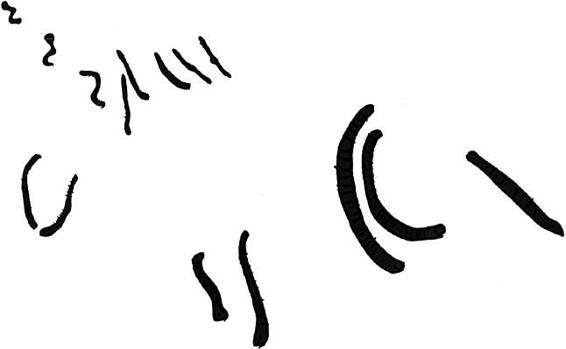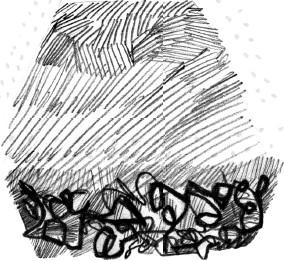Making It: Radical Home Ec for a Post-Consumer World (36 page)
Read Making It: Radical Home Ec for a Post-Consumer World Online
Authors: Kelly Coyne,Erik Knutzen

PATHOGENS IN THE PILE
The subject of pathogens in humanure is complex. In general, if no one in your household is carrying parasites or suffering from bacteria-borne intestinal diseases, your compost pile will not carry these things either—unless they are introduced to it via animal manure. Even so, hot temperatures and long aging will kill most everything. For a detailed discussion of these issues, read Joseph Jenkins’s
Humanure Handbook.
You can buy it in paper form, and he also offers it as a free pdf file at
humanurehandbook.com
. Also, remember these concerns are most pertinent if you’re planning to use the compost on food crops. If you plan to spread it around decorative landscaping or fruit trees, there’s little chance at all of any bad beasties coming back to you.
61>
Worm Farming
Worms eat kitchen scraps and create worm castings, which are a valuable soil amendment and plant tonic. Though castings are often called fertilizer, they’re actually not very high in nitrogen, but they are full of plant-supporting nutrients.
Sprinkle castings on potted plants and over garden beds. A little goes a long way. A handful can go into the bottom of a planting hole to get a plant off to a good start. Unlike nitrogen-rich fertilizers, worm castings won’t burn the plant’s roots. They can also be mixed with potting soil, in concentrations of up to 20 percent castings, to make an extra rich growing medium.
Here’s what you should know before you start: A worm bin is a supplement to a compost pile, not a replacement for one. Worms don’t consume indiscriminately, the way a compost pile does, and they can only eat so much at a time. But as we said above, castings are a fantastic resource, so it’s well worth keeping both a worm bin and a compost bin. That said, a worm bin makes a fine green-waste disposal system for an apartment dweller. If you don’t have yard trimmings to worry about, worms can handle a good deal of your day-to-day food waste—like coffee grounds, wilted lettuce, stale bread, and so on—and give you castings in return that you can apply to container plants.

Worm bins are best kept indoors. Worms thrive in temperatures between 50° and 75°F, and those conditions are usually found in the cool parts of a house, rather than outdoors. During hot summers, worms dig down deep to keep cool. They can’t do that in a worm bin, which will heat up to ambient summer temperatures. In the winter, freezing cold will kill them, too. Of course, it all depends on your climate and situation. If you have cold winters and mild summers, the worms could spend the summer outdoors and the winter indoors. Or in the opposite situation, they could come in for hot summers and stay out for mild winters. You can also take steps to keep the bin’s temperatures reasonable, like insulating it. Just remember that when temperatures are extreme, worms are unhappy.
SOURCING WORMS
While you can buy worms from online suppliers, it’s more fun to get them from a friend who keeps worms or to hunt them in your own garden. Worms from a friend are truly local and already well adapted to life in a worm bin. In addition, they’ve not undergone travel stress. Mail-order worms are understandably freaked out on arrival (as freaked out as worms can be) and will often try to escape from the bin their first few nights until they calm down.
It’s most satisfying to hunt worms in your garden. The worms you want aren’t the big fat night crawlers, they’re the smaller red or purplish worms that live close to the surface of the soil, usually in leaf litter or in cool compost. They are most populous in the spring and the fall and can be hard to find in the summer and winter. Make a trap for them by burying something tasty in your garden beds or in an area rich with leaf litter. Worms adore squash. It draws them like a magnet. You could also use leftover oatmeal or wet bread. Bury these offerings about an inch under the soil or leaf litter and come back in about 3 days. More than likely, you’ll find some worms bellied up to the bar. Scoop them up and take them to their new home.
Worms are hermaphrodites, so they’re not picky about mates. They breed at a rate that puts rabbits to shame. If you’re willing to be patient, you only need to hunt up about a cup of them to get started. If you buy them, you’ll buy a full pound—that’s usually the minimum amount on offer. Whichever way you go, it all works. More worms eat more scraps and make more castings. If you start with lots of worms, the bin will be productive faster. If you start with only a handful of worms, they’ll start breeding as soon as they settle into their new home, and you’ll be up to speed in a couple of months.
WHICH WORM IS WHICH?
Red worms
(Lubricous rubellas)
are the worms you most often find in leaf litter and garden beds, but they also hang out in compost piles. Compost worms
(Eugenia fetid)
are about the same size and can be red, too, but they also come in purple and tiger-striped varieties. These are true compost worms whose preferred habitats are compost and manure piles.
Eugenia fetid
are the type sold for worm bins, but
Lubricous rubellas
adapt to life in the bin very well.
Making a Worm Bin

PREPARATION:
1 hour
Although you can buy or build elaborate multilevel worm composting systems, we’ve come to believe less is more when it comes to worms. A simple container is all you really need.
YOU’LL NEED
- Power drill or a sharp nail and a hammer
- Rectangular plastic storage bin with a lid, any size
- Newspaper and cardboard
- 2 cups ordinary soil, any type
- Red worms
(Lubricous rubellas)
or compost worms
(Eugenia fetid)
PUTTING IT TOGETHER
Using the drill or the sharp nail and a hammer (the latter is much more difficult-use a drill if you can), create two rows of ventilation holes around the top edge of the bin, starting beneath the lid. Space the holes about 3 or 4 inches apart. The exact size of the holes doesn’t matter much, but they should be ¼ inch or less in diameter. To make sure that the bin doesn’t leak and can be kept anywhere, don’t put any holes in the bottom of the container. Lack of bottom drainage means you will have to be vigilant to make sure the contents don’t get too soggy, because there’s nowhere for water to go.
Shred newspaper into fine strips. Use plain newspaper, not shiny inserts, which might contain harmful dyes, and not office paper, which has been bleached. If you have a paper shredder, run the newspaper through that, because the finer the paper shreds, the better. Otherwise, rip the paper into strips. While you’re at it, rip up some plain corrugated cardboard, too, if you have it. It must be bare cardboard, not paper coated, because again, that paper might contain bleaches or inks. It’s easier to rip up cardboard that has been soaked in water first. Worms really like corrugated cardboard—they snuggle up in the channels, so tear it into worm-size chunks roughly 4 inches square.
Wet the newspaper strips by placing them in a bowl or bucket and drizzling water over them and stirring until they’re all equally damp. Add the shreds to the worm bin by the handful, squeezing them first to make sure they’re damp, not sodden. The ideal consistency is that of a wrung-out sponge. You don’t ever want to have standing water in the worm bin.
When you’ve added about 4 to 6 inches of newspaper to the bin, add the cardboard pieces and about 2 cups soil. The soil adds grit to the mix, which helps with the worm’s digestion. Toss it all together to mix it. Add the worms. Put a little paper over them right away because they don’t like the light.

START FEEDING
Theoretically, worms can eat their weight in food scraps each day, but in practice, the amount they eat is highly variable. One factor is newness. A new bin doesn’t eat nearly as much as an established bin, no matter how many worms you start with. It may take a few months for a bin to hit its stride and become an eating machine. In the meanwhile, don’t overfeed. If you add more food than the worms can handle, it will lead to bad smells and possible invasions by undesirable insects.
Start off with just a cup of scraps on the first day. See table below for suggestions. Bury the scraps in one corner of the bin and cover it with about an inch of newspaper. The worms will find the food. After a couple of days, add another cup of scraps in another corner. Proceed cautiously, even if you have lots of worms, because they might not want to eat much at first. Develop an intuition for what is enough and what is too much. While it’s important to feed them plenty if you want them to breed, don’t worry much about their going hungry. If they get hungry between feedings, they’ll eat the newspaper. Eventually, they’ll eat everything in the bin. All of the newspaper, cardboard, and food scraps will be reduced to black gold: worm castings.
WORMS REALLY LIKE:
Coffee grounds and tea leaves
Crushed eggshells
Dry cornmeal, just a sprinkle, as a treat
Fruit of all sorts, except citrus
Lettuce
Oatmeal and other cooked grains
Squash
Wet bread and bready things like cooked pasta
WORMS WILL EAT:
Just about any chopped vegetable matter, fresh or cooked
Newspaper and uncoated cardboard
Rabbit droppings
DON’T FEED WORMS:
Citrus of any sort (It’s antimicrobial.)
Dairy (Traces are okay.)
Meat
Oil
Salty or processed food
Sugar (Traces are okay.)
Vinegar
WHAT TO FEED THEM
Worms aren’t hamsters. They don’t rush to nibble your fresh offerings. Instead, they work in concert with fungi and bacteria to break down rotten food. If it’s not rotting, they’re not interested. That’s why it usually takes a couple days before they approach new food. Overall, they prefer soft food, like oatmeal and squash, to hard food, like carrots. Of course, even carrots will rot eventually, and the worms will get to them then. Don’t put large chunks of food in a worm bin. Take a moment to rip or cut food scraps into small pieces to speed decomposition.
Worms don’t eat vegetable seeds. Nature designed seeds so that they don’t break down easily. More often than not, the seeds will end up mixed in with the castings and thus could sprout wherever you spread the castings. If this concerns you, separate out seeds before you give food to the worms. Send seeds to the compost pile instead.
MAINTAINING THE BIN
Put the bin in a safe, quiet place out of direct sunlight. Otherwise the sun will shine through the plastic walls and irritate the worms. Wherever you stow the bin, be sure the temperatures are moderate. Keep the lid on tight if you have dogs in the house—canines don’t have discriminating palates. Our dog once nosed off the lid on our worm bin and ate half the contents before we stopped him. We don’t know if he was more interested in the worms or the rotten food, but he swallowed it all. If your bin is outside, lock down the lid with a bungee cord to keep raccoons and skunks and other insectivores out at night. And heaven help you if a wandering chicken ever came across your open worm bin!
